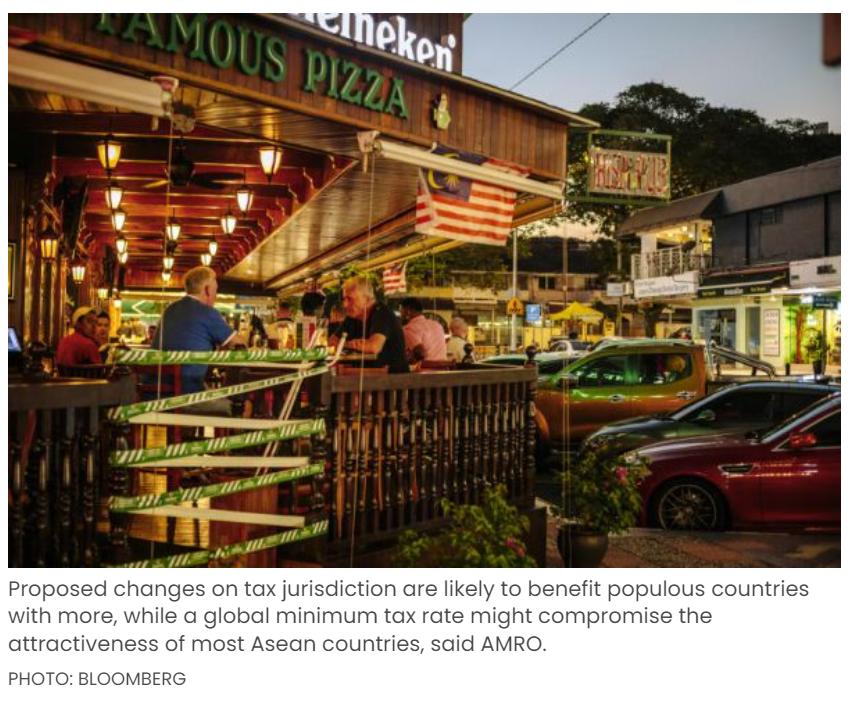For Asean economies, key response to global tax reforms should be to improve non-tax draws: report
IN the face of global tax reforms to tackle base erosion and profit shifting (BEPS), the most important policy response for Asean economies is to enhance their non-tax competitiveness in attracting foreign investment, analysts from Asean+3 Macroeconomic Research Office (AMRO) said in a note on Tuesday.
Proposed changes on tax jurisdiction are likely to benefit populous countries with more, while a global minimum tax rate might compromise the attractiveness of most Asean countries, said AMRO.
In July, the Group of 20 (G20) and Organisation of Economic Co-operation and Development (OECD) inclusive framework on BEPS, which involves 140 economies, released a statement on global tax reform.
Out of Asean+3, Cambodia, Laos, Myanmar, and the Philippines are not participants of the inclusive framework, while the +3 economies of China, Japan, and South Korea are.
The statement has two pillars – first, a multinational enterprise (MNE) may be taxed by a jurisdiction in which it generates revenue, even if it is incorporated elsewhere; second, there is a proposed global minimum tax rate of 15 per cent for large MNEs.
The OECD estimates that the first pillar could reallocate taxing rights on more than US$100 billion of profit, while the second could raise an additional US$150 billion in global tax revenues each year.
The first pillar will likely benefit economies with a large population, high income, and significant digital economy, said AMRO. China and Japan are likely to gain significantly, while populous middle-income economies such as Indonesia, the Philippines, Thailand, and Vietnam may gain moderately.
Despite their smaller populations, Brunei, Hong Kong, South Korea, Malaysia and Singapore “also stand to gain moderately, given their relatively higher incomes per capita”, added AMRO.
However, economies with a higher concentration of affected MNEs’ international or regional headquarters – such as Hong Kong and Singapore – could see some reduction in collectible taxes.
As for the second pillar of a minimum effective tax rate, this could hurt economies with effective tax rates below this floor.
AMRO estimates that for MNEs from the United States, average effective tax rates are below 15 per cent in Cambodia, Hong Kong, South Korea, and Singapore.
“Ceteris paribus, these economies will be less attractive to existing MNEs and potential investors as the attractiveness of their tax incentives diminishes,” said AMRO.
Apart from taking this opportunity to fine-tune their tax systems, the most important policy response by Asean+3 economies should be to improve non-tax competitiveness, said AMRO.
AMRO constructed a foreign direct investment market attractiveness score based on non-tax indicators such as strength of institutions, human capital, and macroeconomic stability. Based on this, Singapore, Hong Kong, and the +3 economies remain attractive, while the competitiveness of other Asean economies is lower.
Economies with both a lower-than-average attractiveness score, and effective tax rates below or close to the proposed rate – Cambodia and Brunei – “would likely need to raise their value propositions further” to continue attracting FDI.
In Indonesia, Malaysia, the Philippines and Thailand, the effective tax rates faced by US MNEs are already above 15 per cent, and authorities may not make significant changes to their corporate income tax rates. “Nonetheless, it will still be important to raise their non-tax attractiveness from the current moderate level,” said AMRO.
Source: https://www.businesstimes.com.sg/asean-business/for-asean-economies-key-response-to-global-tax-reforms-should-be-to-improve-non-tax


 English
English




